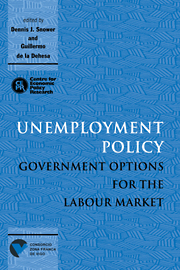Book contents
- Frontmatter
- Contents
- List of figures
- List of tables
- Preface
- Acknowledgements
- List of conference participants
- 1 Introduction
- PART ONE GENERAL POLICY ISSUES
- PART TWO DEMAND MANAGEMENT AND SUPPLY-SIDE POLICY
- PART THREE SUBSIDISING EMPLOYMENT AND TRAINING
- PART FOUR LABOUR MARKET REGULATIONS
- PART FIVE POLICY, JOB REALLOCATION AND THE UNEMPLOYMENT–PRODUCTIVITY RELATION
- PART SIX COMPARING UNEMPLOYMENT POLICIES
- 16 Unemployment in the OECD and its remedies
- Discussion
- Discussion
- 17 The unemployment and welfare effects of labour market policy: a comparison of the USA and the UK
- Discussion
- Discussion
- Index
Discussion
Published online by Cambridge University Press: 07 September 2010
- Frontmatter
- Contents
- List of figures
- List of tables
- Preface
- Acknowledgements
- List of conference participants
- 1 Introduction
- PART ONE GENERAL POLICY ISSUES
- PART TWO DEMAND MANAGEMENT AND SUPPLY-SIDE POLICY
- PART THREE SUBSIDISING EMPLOYMENT AND TRAINING
- PART FOUR LABOUR MARKET REGULATIONS
- PART FIVE POLICY, JOB REALLOCATION AND THE UNEMPLOYMENT–PRODUCTIVITY RELATION
- PART SIX COMPARING UNEMPLOYMENT POLICIES
- 16 Unemployment in the OECD and its remedies
- Discussion
- Discussion
- 17 The unemployment and welfare effects of labour market policy: a comparison of the USA and the UK
- Discussion
- Discussion
- Index
Summary
Using the general equilibrium, job creation/destruction model of Mortensen and Pissarides (1994) (henceforth MP), Millard and Mortensen in chapter 17 (henceforth MM) pose the interesting question: to what extent are differences in US and UK unemployment rates due to differences in labour market policies and institutions? The gross flow approach, especially as elucidated in the MP model as well as Pissarides (1990), stresses the dynamics of labour markets at the expense of neglecting other, static aspects. In an economy with two states of labour force participation, the equilibrium unemployment rate is roughly equal to the product of an incidence rate and an average expected duration. Active labour market policies affect equilibrium unemployment by changing incidence, duration, or both. In addition to studying the effects on unemployment and output, MM have tried to ask the harder welfare (here: consumption) question in the context of their model, which is not necessarily a monotone decreasing function of the unemployment rate.
The equilibrium approach employed in chapter 17 has several advantage. First is the well known absence of $50 bills lying round on the sidewalk. Even though there are frictions built into the model, agents are free to do the best they can under the circumstances to deal with them and exploit available profit opportunities. Second, the model explicitly analyses flows of jobs (and thereby workers) in the labour market. Job creation and destruction have efficiency implications in the MP model, which can be affected by policy.
- Type
- Chapter
- Information
- Unemployment PolicyGovernment Options for the Labour Market, pp. 575 - 578Publisher: Cambridge University PressPrint publication year: 1997



